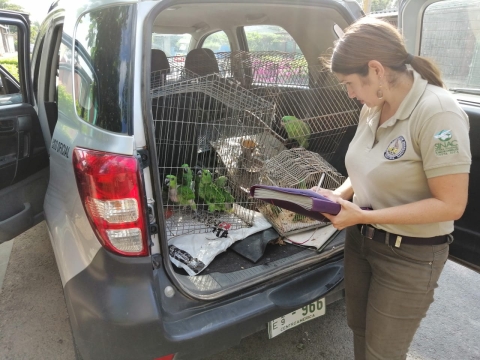We are a science-based organization. We subscribe to the highest standards of scientific integrity and reflect this commitment in the design, delivery and evaluation of all our work, and a robust and sound science program is one of our strongest weapons to conserve wildlife in the changing world. The following Conserving the Future tools provide increased certainty in management decisions at all levels, help us scale data up to large landscapes, contributes to the broader scientific community, and encourage collaborations with partners by developing common conservation frameworks.
Data Management
Conserving the Future envisioned a data system that would be widely used and populated with data from every refuge. The plan values both historic and new monitoring that can be shared and leveraged in as many ways as possible to maximize its value while diminishing its overall cost.
Integrated Web Tools
Conserving the Future combined forces with the National Park Service’s Environmental Conservation Online System or ECOS ECOS
Environmental Conservation Online System (ECOS) serves a variety of reports related to FWS Threatened and Endangered Species.
Learn more about ECOS to consolidate and house a suite of data applications. The newest of which are The Service Catalog or ServCat, and the Integrated Refuge Information System or IRIS which houses two applications the Planning and Review of Inventory and Monitoring Activities on Refuges or PRIMR and the Water Resources Inventory and Assessment of WRIA (Coming Soon). These tools support data collaboration across disciplines and agencies, and help meet the goals of the President’s Open Data Initiative.
For more information visit the Natural Resource Program Center
Citizen Science Framework to meet Research, Management, and Citizen Engagement Conservation Goals
Coming Soon
To meet the mission of the National Wildlife Refuge System, and adapt to rapidly changing climate conditions, we must collect and use relevant and scientifically credible information at multiple spatial and temporal scales. Engaging volunteers in scientific research can meet multiple goals for biological inventory and monitoring, citizen engagement, and foster the next generation of conservation stewards. We are developing a framework tool that field stations can use to effectively collect defensible data and to engage and educate citizens about conservation through science activities. We expect to pilot test the framework during the summer of 2016 with an expected release date later in the year.
Effective Natural Resource Management - Creating a solid science foundation and a culture of learning
Coming Soon
The National Wildlife Refuge System is committed to providing each refuge with access to resources to fully implement the foundational principles of adaptive management. The Refuge System is currently drafting a peer reviewed guidebook and recommendations that will provide refuge staff guidance in ensuring that natural resource management is grounded in sound science and set up to allow continued learning and adaptation as necessary. The guidebook and recommendations are expected to be completed and released by winter of 2015.
Priorities
With ever increasing natural resource challenges, declining budgets and and staff, Refuges need to strategically plan for the future of the biological program. Collaboration across boundaries is also key, so pursuing similar biological protocols will help make decisions about wildlife conservation across the landscape.
Inventory and Monitoring
This Inventory and Monitoring 7-Year Plan: 2013-2020 (7-Year Plan) outlines how the National Wildlife Refuge System (Refuge System) is implementing a nationally coordinated effort to support rigorous inventories and monitoring at the refuge, landscape, regional, and national scales. As part of Conserving the Future a new Inventory and Monitoring Policy has been finalized that helps the field prioritize by creating Inventory and Monitoring Plans or IMPs. An IMP is the description, ranking, selection, and justification of surveys that a refuge intends to conduct using assigned protocols.
A User's Guide for SMART Survey Prioritization Tool
This guide for aids NWRS Station staff when prioritizing their surveys for an Inventory and Monitoring Plan This guide describes a process and a tool that can be used to prioritize surveys. The tool is a spreadsheet that uses a simple, multi-attribute ranking technique SMART which can be used for the Inventory and Monitoring Plan decision making process for refuge surveys. Users evaluate the surveys using scores from up to 24 criteria, which use weights of relative importance assigned at the onset of the prioritization process. The tool and approach can be used to help resolve differing opinions regarding the relative importance of each survey.
Defining Research Needs for Refuges
The new Research Agenda Database provides a forum for Refuges to identify research needs that are management-oriented and grounded in testing assumptions, with the explicit purpose of reducing uncertainty in planning and management decisions. This tool positions the Refuge System to focus time and resources on the most pressing natural resource needs.




